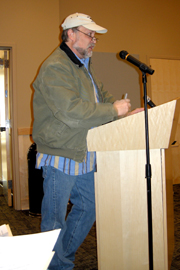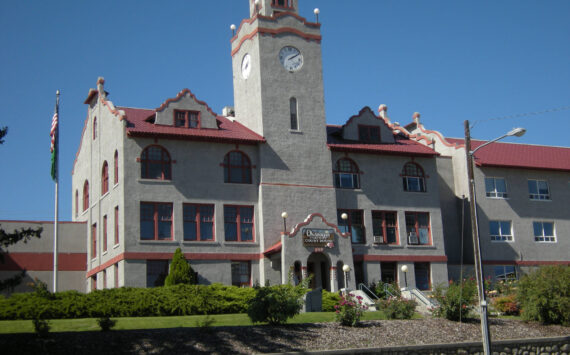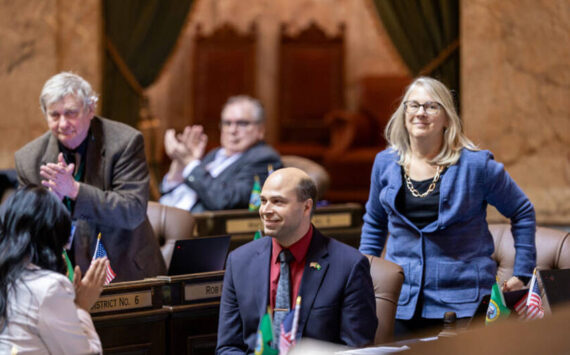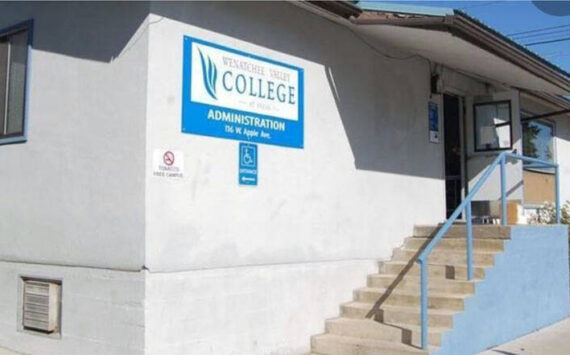
Tonasket’s Jim Morgan speaks to the Okanogan County Public Utility District’s commissioners during their board meeting on Tuesday, April 5. “We hire you to look out for us and I don’t feel you’re doing that,” Morgan said. Photo by Emily Hanson
OMAK – The boardroom of the Okanogan County Public Utility District was packed with customers angry over the higher energy rates and how these rates are affecting their lives during the PUD commissioners’ board meeting on Tuesday, April 5.
Since the energy rate discussion was not on the commissioners’ agenda, the attendees spoke during the public comment period and the commissioners listened to them for over an hour before ending the period to continue with their meeting.
Starting off the comment period was William Bordua, who stated he was representing his neighbors.
“They simply can not absorb this price increase,” Bordua said. “They can hardly live in this county as is. We can’t take this kind of lump increase. You guys can pass your costs on to us, but as the consumer, we have no one else to pass our costs on to.”
In July 2010, the PUD energy rates for residential areas increased from 4.4 cents per kilowatt hour (kWh) with a $10 monthly basic charge to five cents per kWh with a $10 monthly basic charge and a $15 minimum energy charge for those costumers who use 2,000 kWh or less a month. The $10 basic charge covers the first 300 kWh and after that, energy costs five cents per kWh. For those customers who use more than 2,000 kWh per month, their energy costs increase to 5.682 cents per kWh.
“If you used 2,000 or less, it’s a $1.80 per month increase,” John Grubich, PUD general manager, said separately from the meeting. “If you’re using over 2,000 kWh per month, the increase you’ll see depends directly on your energy usage. This is called an inverted rate block. We’re in a load resource balance, which means the amount of energy we have available to us is the same amount we use on an annual basis. The inverted rate block is to promote conserving energy.”
Jim Morgan of Tonasket told the commissioners that they were elected to look out for the customers of the PUD and he doesn’t feel they are doing their jobs.
“We hire you to do a job so we don’t have to do it,” Morgan said. “You guys have either got to do your job or find a new job. Your math is wrong on this.”
Joanna Harrison said before the rate increases came into affect, she was paying $84 per month all winter but her bill for the month of February was $169 after the bill ate up the credit she had accrued over the year.
“I would like to know how many of your employees asked for a big raise,” Harrison said. “This is a time when everybody has to tighten their belts. The PUD is supposed to be for the people and not for profit. I don’t understand why we needed this big building and why we needed all new equipment.”
Outside of the meeting, Grubich said that while the pay raises the PUD employees received have affected the rates, the affect is very, very minimal.
“On a $42 million operating budget, $270,000 would be increased wages,” Grubich explained. “It’s a very small percentage. It is just a little over half of one percent of the budget. The total amount of the pay raises is half of what it would cost for the PUD to build the line between Pateros and Twisp.”
Grubich also explained where the money for the new building came from.
“In prior years, we had wholesale sales where we periodically have more energy than what we consume and we sell it to anyone in the Pacific Northwest who wants to buy it,” he said. “Of those sales, about $7 million were earmarked to build this building. The decision was then made that, to get the $7 million back into our reserves, we should use the project as a bond proceeds and doing this saved the consumer on rate increases. Had we not used bond proceeds and just tried to recover the money in rates, we would have had to raise rates to about .005 cents per one kWh to get the money back.”
Grubich explained that the building was needed for multiple reasons. In the old building, the electrical system, the heating system, the air conditioning system and the plumbing system were all failing. The old building has asbestos and was not up to code. Also, eight of the PUD employees could not work in the building because there was not space for them. Work began on the new building in May 2009 and the PUD officially moved in during the month of July in 2010.
When Dan Taylor told the commissioners that he has seen bills go up 300 percent, Secretary David Womack stated that he challenges any one who says their bill has gone up 300 percent to bring their bills to the commissioners for an investigation.
“If someone’s bill has increased that much, we need to see that,” President Ernie Bolz said.
Although it is certainly not a 300 percent increase, John Martin said that for 33 days this year, his bill was almost higher than it was for 61 days at this same time of year last year.
Bolz explained that the PUD had not raised rates for nine years and why a rate increase was needed now.
There are costs associated with having electricity and we have kept them low for a long time,” he said. “We went nine years without a rate increase. That was a mistake and the costs of providing power went up sometimes by 80 percent. We absorbed those costs with our wholesale power sales. We used that money to keep the rates low. Because of the recession, the price for wholesale power went down. The river level was lower and there was less power produced, so the rates went up. We’re trying to modernize because a lot of the equipment is 50 years old and it has to be replaced. We moved everything onto computers and that took a lot of time and money to do, but now we can service areas faster and better because we know where everything is; we know where the power is going and where it’s coming from.”
Bolz advised everyone to watch their bills for one year and during that year to observe the weather patterns and their own energy usage. He said doing this would give PUD customers a better understand of what was going on with their bills.
Outside of this meeting, Grubich stated that the rate would increase again this July. The basic charge will stay at $10 per month while the residential fee for users of 2,000 kWh or less per month after the first 400 kWh would be five cents with a $20 minimum energy charge while the rate for those who use more than 2,000 kWh per month would be .0577 after 2,000 kWh. Another increase will occur in July 2012. Again, the basic charge will remain at $10 but the minimum energy charge will increase to $25. After the first 500 kWh, consumers who use 2,000 kWh or less will be charge .0575 per kWh while those who use more than 2,000 kWh will be charge .06316 per kWh.
“There’s an automatic three percent increase each year after 2012 but the board can suspend that increase at any time,” Grubich said. “For example, if the wholesale prices go back to what they were, the board can say we don’t need the increase this year. The residential rates were designed to be an overall increase of 9.5 percent because when we did the cost-rate analysis, we realized the old rates were about 22 percent below the costs of service.”
During the meeting, Grubich told the attendees that the new meters that were installed are maybe one to two percent more accurate than the old meters were.
“The new meters help us understand the usage of t
he county,” he said. “We are planning for 10 to 20 years out and that is why our decisions may seem not to make sense. Our costs are going up and we can not reduce that but we can reduce the increase our consumers see.”
Finally, outside of the meeting, Grubich said that Okanogan County has the fifth lowest PUD rates in the state of Washington.
“We are under all except Pend O’rielle, Chelan, Douglas and Grant counties,” he said. “The reason their rates are lower than ours is because they have their own generation source.”
The PUD’s next board meeting will be at 2:30 p.m. on Tuesday, April 19. That evening, at 6:30 p.m., there will be an information meeting for anyone who has any other questions for the PUD.




